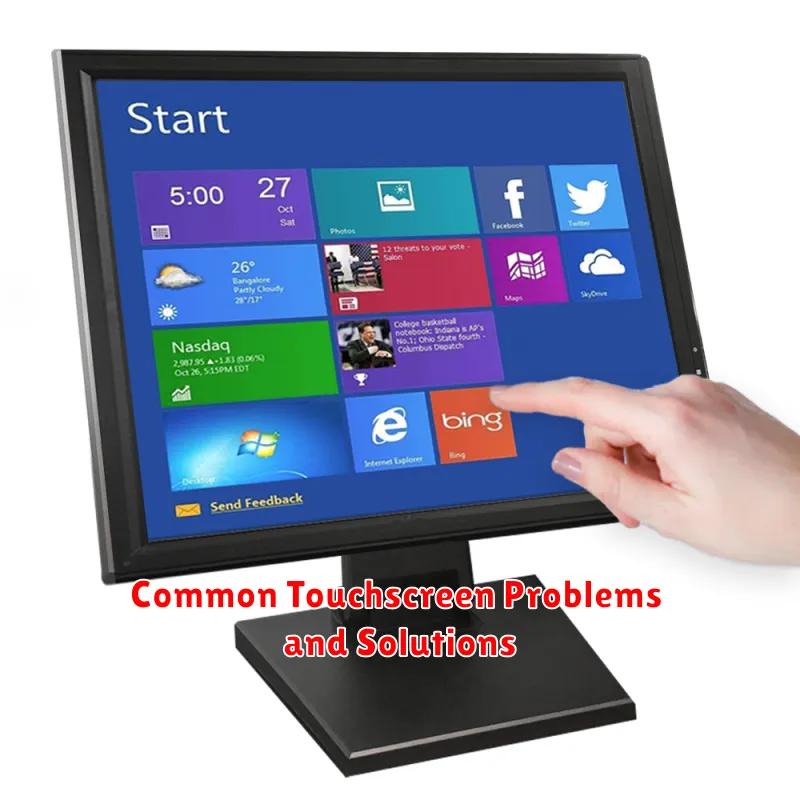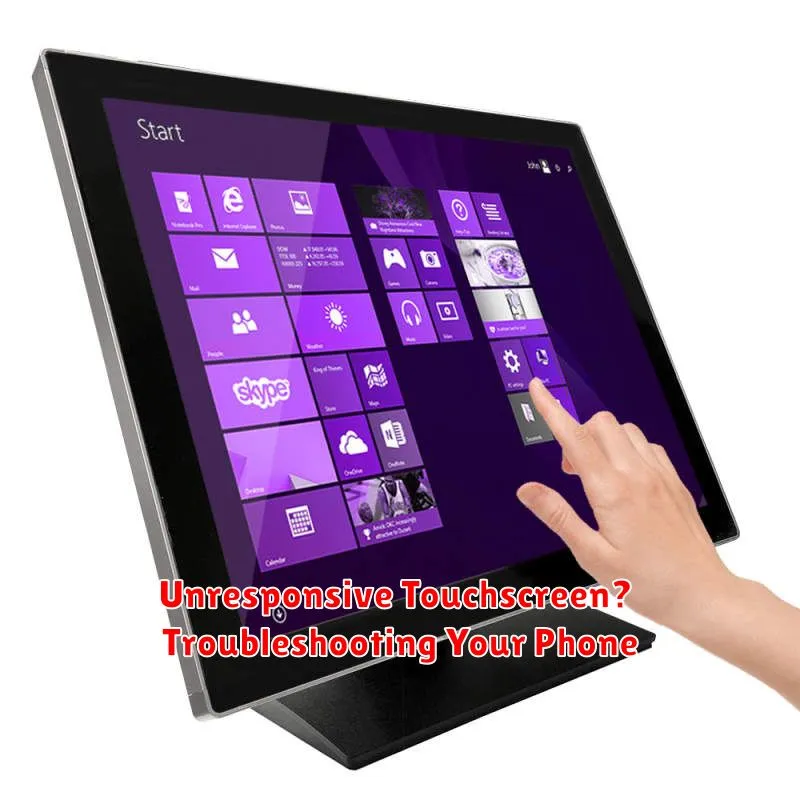Experiencing an unresponsive touchscreen on your phone can be incredibly frustrating. Whether your phone’s touchscreen is completely unresponsive, intermittently freezing, or only partially registering touches, this issue can severely limit your device’s functionality. This article offers comprehensive troubleshooting steps to help you diagnose and fix the problem of an unresponsive touchscreen on your Android phone or iPhone. From simple solutions like restarting your device and cleaning the screen to more advanced techniques, we’ll guide you through the process of getting your touchscreen working properly again.
Before you panic and consider costly repairs, many touchscreen issues can be resolved with simple troubleshooting methods. We’ll explore various potential causes for an unresponsive touchscreen, including software glitches, hardware problems, and environmental factors. By following these steps, you can often pinpoint the source of the problem and potentially fix your unresponsive touchscreen yourself, saving you time and money. Let’s begin by examining the most common and straightforward solutions.
First Steps: Basic Troubleshooting Tips
Before diving into complex solutions, try these simple troubleshooting steps for an unresponsive touchscreen.
1. Clean the Screen
Dirt, grime, and fingerprints can interfere with your phone’s touch sensitivity. Gently wipe the screen with a clean, soft, slightly damp (with water only) microfiber cloth. Avoid using harsh chemicals or abrasive materials.
2. Remove Screen Protectors or Cases
Sometimes, thick screen protectors or bulky cases can impede the touchscreen’s responsiveness. Temporarily remove them to see if this resolves the issue. Ensure the protector isn’t lifted or damaged.
3. Check for Moisture
Even minor moisture can affect touchscreen functionality. If your phone has been exposed to water or humidity, carefully dry it. Do not use a hairdryer or apply direct heat.
4. Try a Simple Restart
A simple restart can often resolve minor software glitches that may be causing the unresponsiveness. Power off your device completely, wait a few seconds, and then power it back on.
Software Glitches: Restarting and Updating
Sometimes, a frozen or unresponsive touchscreen is simply the result of a temporary software glitch. A simple restart can often resolve these issues. Restarting your phone clears the active memory and closes any malfunctioning apps that might be interfering with the touchscreen’s responsiveness.
Updating your phone’s operating system and apps is also crucial. Software updates frequently contain bug fixes and performance improvements, including patches for touchscreen issues. Ensure you’re running the latest versions to minimize potential conflicts.
Here’s a quick guide:
- Restart your phone: Typically, this involves holding down the power button and selecting the restart option.
- Check for system updates: Navigate to your phone’s settings and look for the “Software Update” or “System Update” section. Download and install any available updates.
- Update your apps: Open your app store and check for updates to your installed applications.
Identifying Hardware Issues: Physical Damage and More
Sometimes, an unresponsive touchscreen stems from physical problems rather than software glitches. Carefully inspect your phone’s screen for any visible signs of damage.
Cracks, chips, or deep scratches can disrupt the touchscreen’s functionality. Even if the damage appears minor, internal components could be affected.
Check the screen connector. If your phone has been disassembled before, the connection between the screen and the motherboard might be loose. However, accessing this usually requires technical expertise and is not recommended for most users.
Water damage can also cause touchscreen malfunctions. Look for signs of corrosion or discoloration around charging ports or other openings.
Overheating, while often a software issue, can sometimes indicate a problem with the hardware managing power delivery to the screen. Persistent overheating, even with minimal usage, should be investigated further.
DIY Fixes: Potential Solutions to Try
Before resorting to professional repair, there are a few DIY fixes you can attempt. Disclaimer: These solutions may not work for all situations and attempting them is at your own risk.
1. Recalibrate the Touchscreen: Some phones offer a built-in calibration tool within the settings menu. This can help resolve minor responsiveness issues.
2. Remove Screen Protector: If you’re using a screen protector, try removing it temporarily. A thick or damaged protector can interfere with touch sensitivity.
3. Clean the Screen: Gently clean your screen with a soft, slightly damp (with water only) microfiber cloth. Ensure the phone is powered off during cleaning.
4. Discharge Static Electricity: Sometimes, built-up static electricity can affect the touchscreen. Power off your phone and let it sit for a few minutes to discharge.
Seeking Professional Help: When to Contact a Technician
While some touchscreen issues can be resolved with DIY troubleshooting, others require professional intervention. Knowing when to seek expert help can save you time and prevent further damage to your device.
Consider contacting a qualified technician if:
- You’ve tried all basic troubleshooting steps and the problem persists.
- There’s visible physical damage to the screen, such as cracks or deep scratches.
- The unresponsiveness started after exposure to water or extreme temperatures.
- The phone exhibits other malfunctions alongside the touchscreen issue, such as erratic behavior or unexpected shutdowns.
Choosing a reputable repair service is crucial. Authorize repair centers for your specific phone brand are generally the best choice. They use genuine parts and have trained technicians familiar with your device’s intricacies. Inquire about warranties on repairs and ask for a clear explanation of the diagnostic process and estimated costs.
Preventive Measures: Protecting Your Touchscreen

Protecting your touchscreen from damage and prolonging its lifespan involves several key strategies. Screen protectors are essential. Invest in a high-quality screen protector that fits your phone model precisely. This thin layer of tempered glass or plastic shields the screen from scratches and minor impacts.
Clean hands are crucial. Regularly wash your hands before using your phone to prevent the buildup of oils and grime that can hinder responsiveness. Use a microfiber cloth to gently clean the screen, avoiding excessive pressure.
Proper storage also plays a vital role. Avoid keeping your phone in pockets with keys, coins, or other sharp objects. Use a protective case to cushion the phone against accidental drops and bumps.
Temperature awareness is important. Extreme temperatures can adversely affect touchscreen performance. Avoid leaving your phone in direct sunlight or freezing conditions.
Common Touchscreen Problems and Solutions

Ghost Touches: If your screen registers touches randomly, a software glitch or a failing digitizer could be the culprit. Try restarting your phone. If the problem persists, a factory reset might resolve software conflicts. Persistent ghost touches often indicate hardware failure, requiring professional repair.
Unresponsive Areas: Specific areas not registering touch might signify a damaged digitizer or underlying hardware issues. Test with a touchscreen tester app to pinpoint the unresponsive zone. If the issue is localized, hardware repair is likely necessary.
Delayed Response: A slow or lagging touchscreen can be due to a demanding app, insufficient RAM, or outdated software. Close unnecessary apps running in the background. Updating your phone’s operating system and apps can also improve responsiveness.
Over-Sensitivity: If your screen registers touches too easily, check your screen protector. A thick or poorly installed protector can interfere with touch sensitivity. Removing or replacing it might solve the problem.

